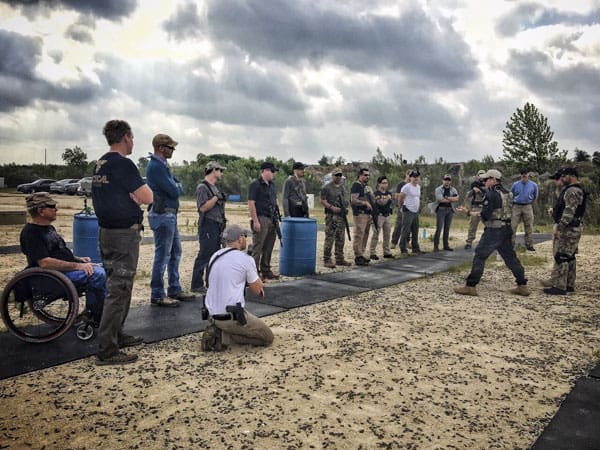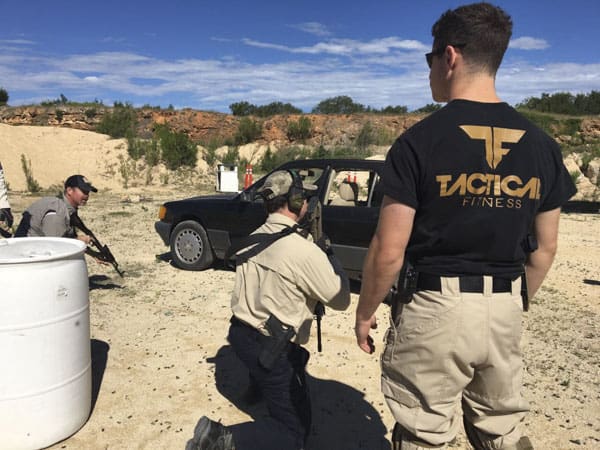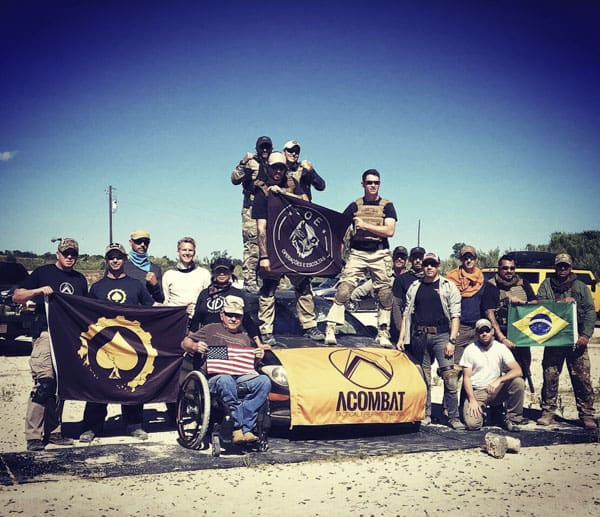
I get tired of basic firearms courses. They teach the same techniques, often the same way. So when Ron Grobman of Tactical Fitness of Austin invited me to his Vehicle Close Combat course –taught by a brace of Brazilian police officers — I perked up. I wanted to see if their techniques, tactics and procedures were much different from those that I’d learned in the U.S. Army.
Few people in the world have as much practical gunfighting experience as the Brazilian police. The South American nation is home to some 50,000 murders per year. In Rio de Janeiro alone, gangs kill more than 100 officers each year. This year, they’ve already passed 50 fatalities.
On the other side of that equation, Amnesty International reports that Brazilian police killed over 8,000 civilians in 2014. The Brazilian authorities contest that stat, but there’s no debate that their cops and gangs are at war.
Whereas officer deaths by suspects firing AK-47s are non-existent in the U.S., they’re common in Brazil. The gangs shoot AK’s at cops in complex ambush operations; criminal teams use coordinated fire tactics against police.
Cops have bounties placed on them. Police kidnapping, torture and mutilations make regular appearances in the news. Needless to say, when the cops roll through Rio, they roll ready for war. When driving through urban areas, police are routinely armed with hard plate armor and patrol rifles.

The course is taught by an IDF veteran and two current Brazilian SWAT officers.
Marcelo Esperandio is the owner of Esperandio Tactical Concepts. A Brazilian Army vet, Mr. Esperandio is now a SWAT officer with Santa Catarina, with additional duties as an aerial operations officer and a SWAT instructor.
Claudio Andrade is the owner of Andrade Combat. The former Brazilian Marine is also a current SWAT officer in Rio de Janeiro. Mr. Andrade heads up the Rio de Janeiro Tactical Intervention team and works on the hostage rescue team.
Ron Grobman is the owner Tactical Fitness Austin. Mr. Grobman is a former Israeli Defense Forces Special Operations Sniper and a current Krav Maga instructor in Austin.
All of the course material was provided by Mr. Esperandio and Mr. Andrade. Mr. Grobman hosted the course and handled the Portuguese to English translation.
Mr. Grobman also acted as a dedicated safety officer for the range. I wish a lot more courses followed that protocol: one person dedicated entirely to safety. In a highly mobile, live round course where students operate in teams, that level of safety monitoring is vital.

The course was run at a large section of a private range just north of Austin, Texas. The “classroom” included scrap vehicles repositioned inside each of two three-sided burmed bays. Each bay had steel and paper targets out to 25 yards, and a covered area with tables for gear.
Day one started with a safety briefing and weapons modification. We installed a rod or tube into our pistols’ barrel and breach to prevent chambering a live round, and removed our rifle bolts. Prior to each exercise, we performed buddy checks for all weapons and magazines to ensure they were empty.
With that done, we moved right into firing positions, including kneeling, squatting and urban prone.
Kneeling and squatting were self-explanatory. The instructors put extra emphasis on loading up our front leg in the kneel for stability, as well as maintaining the squatting position for mobility.
The urban prone position is for firing from an extremely low position, such as shooting under a car or hiding behind a curb. Although both instructors practiced it, they’ve never used urban prone in combat. I’ve seen it used in combat, but find that the mobility you sacrifice is rarely worth the potential cover.
But if you fall down, either from accident or injury, the urban prone position lets you continue accurately pouring rounds on target. That right there makes it valuable. The key: get up and move as soon as you can. (Oddly enough, I’ve only used it once when deer hunting.)

We moved on to taking cover. Remember: cover is when you have protection from bullets. The definition of cover depends on the type of weapon employed against you and the duration of the fight.
Mr. Esperandio and Mr. Andrade made sure that everyone knew to back away from cover. Never be right on top of it; push back a good three meters if you can. That gives you a much better field of view and protects you from bullet splash and ricochets.
Mr. Esparandio provided an excellent demonstration of the dangers of crowding your cover.
With a “terrorist” photo target standing up against the front fender of a vehicle, he shot the door at an obtuse angle (less than 33 degrees) with a AR15 chambered in 5.56NATO. The bullets skipped right off the door and into the target, at pelvic level. If the target had been hugged-up next to that front fender for cover, that would have been an upper chest/head shot for sure. Back off the cover even a few feet and the round sails right by you.
Like most people, I tend to run to cover and get down. Even when I was training every day, I couldn’t train myself out of the habit. So I added an extra step: running to cover and then pushing off from the barrier. That put me more than an arm’s length away, usually more.
Most of the course assumed a firing distance of 25 yards or less. So the emphasis was on movement, not on perfect position. The course instructors repeatedly asserted that mobility equals life in a CQB situation. Copy that. Too often we’re taught to seek cover, fire from there and . . . that’s it.
Being married to your cover is a huge tactical mistake, and often a deadly one. This course helped train us move from position to position; firing, reassessing and moving again (if necessary).
Next up: two-man teams.
The course taught us how to move with our pistol or rifle safely — so we didn’t point the gun at ourselves or our partner. We also learned how to create as little of a profile behind cover as possible, and how to slice the pie as a team.
These are the kinds of drills I ran in Afghanistan for hours, days, and months on end. It is, apparently, a perishable skill. After six years without two-man training, I found myself constantly out of position, too far away from my partner, or in the wrong place for cover during reloads.
The final drills included bounding and peeling in two- and three-man teams. We had to make sure we were away from our partner’s muzzle prior to bounding and stay in contact with our partner — a skill set that has to be hammered into you through repetition.
To be clear, this was all an introduction to the techniques. It takes at least a couple of weeks of constant practice with solid coaches to get these drills down pat.
After a quick lunch, we got down to live fire versions of most of the drills we’d done in the morning (excluding the two- and three-man bounding drills). Throughout the live-fire portion, the instructors focused on safety and control. Mr. Esparandio reminded everyone to slow down. Not to do these drills as fast as we could. To do them safely, and technically correct.
Also appreciated: the instruction to move away from double taps or controlled pairs. The instructors repeatedly told us to shoot as many times as we wanted — at least four but sometimes five, six and seven times per target. This made the class a fairly high round count course, especially as it isn’t a shooting course as much as a tactics course.
The last thing we worked on for the day was the correct way to pie a hallway or a room as a single or as a team.
I see a whole lot of people teaching students to slice the pie, to observe an area while under as much cover as possible. Most of them get it wrong. The key is to imagine the tip of your muzzle as fixed in space, and the rest of you rotating around it.
I’d done all of these drills with a rifle, but I’ve ever done them in a team with a pistol. I found it much more difficult to be in the right place with my partner and my muzzle when trying to pie into an alleyway or room. It was both a refresher and an eye opener.
The second day started with all Vehicle Close Quarters Combat: how to fight from inside of the vehicle, get out quickly and to use the vehicle as effective cover prior to finding new cover.
The class divided in two. Each instructor had their own bay and vehicle. Individuals and teams could run the drills in live fire multiple times while still getting direct observation and coaching from one of the instructors.
One of the first things we learned: a vehicle has relatively few places that provide cover from even a pistol round. Yes, a pistol round will be slowed, and maybe deflected, and that’s good. But you can’t count on that.
The instructors proved that a 9X19 round sails through multiple body panels, the doors and the posts at close range. A pistol or rifle round won’t go the engine block and the wheels. So we worked drills on getting to those relatively safe points and shooting from them in multiple positions, kneeling, squatting, and urban prone.
The real fun started when we worked ambush drills. There were two scenarios: one where you saw it coming and one where you didn’t.
In the first drill we had just enough warning to get our gun out and up. For those drills, we fired the first rounds through the windshield at our target. Those rounds deflect up. The rate of deflection depends on the angle of the glass.
Given the deflection and the fact that your opponent gets to change distances and angles, training to accurately put shots on target from inside a car is wasted time. We were taught to put holes in the glass and shoot through those holes.
After my first five shots, my next three went straight into the metal silhouette (15 yards distant).
We were reminded that after our first shot, we’re going to be blind and deaf, for at least for a minute. That glass will instantly spider-web, making visibility extremely limited. If you aren’t wearing ear protection, well, that’s not going to go well. If you’re doing this for training, I recommend you double up on ear-pro.
The real key is to get out of there as fast as possible. The car is not cover. As the instructors reminded us several times, the car is your grave. Get out of it as fast as possible, head to whatever section of the vehicle is cover for you, return fire, then head for better cover.
For an ambush where you don’t see it coming, you just have to get out of there. Or, as we in the US would say it “Un-ass the AO.” Don’t bother pulling your weapon. Just get that door open and get out as fast as you can. Draw under the first cover you can find (likely the vehicle itself), return fire, then get to a better position.
There are a few things to note about this course.
Again, this is a high round count course. I ran most of the course with 9mm carry gun, but did some of the first day with my home-made AKM47. I fired 300 rifle rounds real quick. Budget appropriately.
Since this isn’t a shooting course, don’t expect a lot of marksmanship instruction. So show up already knowing how to put rounds on target up to the 25 yard line. Even with the high round count, the instructors marksmanship lesson was clear, and singular; “shoot fast, but do not miss.” That’s especially important for an urban environment, remember, you own every round fired.
Lastly, this is a moderately physical course. Expect to run, fall, jump, kneel, shoot and scoot. Be in shape to do those things, and dress accordingly. And as there’s a whole lot of information, take photos and notes so you’ll have something to review later.

The training was nothing dramatically different at all than some of the small unit tactics I learned in the US Army, but it was succinctly delivered, safely, and with tons of individual, hands-on attention. I was very impressed, and I’d take a course from these guys again any day.
SPECIFICATIONS:
Tactical Fitness Urban Combat Weekend, CQB and VCQB Course
http://www.tacticalfitnessaustin.com
Cost :$499
RATINGS: (out of five stars):
Overall * * * * *
A great course taught by knowledgeable instructors with a lot of real world experience. Tons of hands-on learning and lots of individual attention. You’ll take away a lot of knowledge that you can then drill on your own time. Great instructors with fantastic attitudes. No tough-guy BS, just quality, professional instruction all the way around. Well worth the price of admission.




Finally, some fresh air in a shooting course. By real operating operators no less.
Hugging cover is a tough habit to break.
I’m thinking being a swat cop in Rio is something that puts a price on your head more than the regular cops. Can’t imagine living in code red 24/7.
This training will come in handy. In America. For a SWAT team. If they actually did this kind of stuff. Which they don’t.
Awesome! Good read, and it sounds like a great course. The last time I bumped into Grobman on the range he handed me his G19 and told me to run through an urban pistol combat class setup while he called out which target to engage. I got all up on my cover, and transitioned between cover holding the gun more like I was shooting a competition or an 80s action movie than Operating operationally. I could serve to be more tactical haha. I did make good hits, though 😉
This is a great course for professionals. If you are not a professional it is Walter Mitty time — unless you live in a place like Chiraq.
Off-duty cops in Brazil bring the red circle of death!
On the other side of that equation, Amnesty International reports that Brazilian police killed over 8,000 civilians in 2014. The Brazilian authorities contest that stat, but there’s no debate that their cops and gangs are at war.